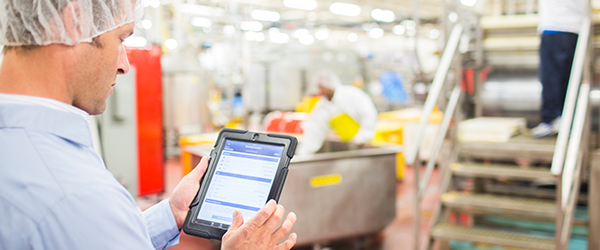Mobile Coaching Technology Buttresses Food Safety Efforts

It’s a truism in the food industry that one of the keys to ensuring food safety is a focused, well-trained frontline workforce. And employee training in the food industry generally adheres to the following model: workers receive classroom instruction via slide presentation or, if they’re lucky, interactive technology, followed by quizzes or tests to confirm that the desired information has stuck. If quiz scores are high enough, employees are sent to the plant floor, and management assumes that knowledge acquired through training will be correctly and consistently applied.
But mistakes still occur—one study shows that as much as 90% of new training knowledge can be forgotten within a week.1 Needless to say, such knowledge degradation can have serious food safety consequences. And this obviously causes frustration among managers.
Stop knowledge degradation
More and more food companies are addressing the problem of knowledge loss and on-the-floor errors through means such as periodic short-burst refresher trainings, daily team huddle talks that focus on selected food safety topics, and prominent posters and digital signage that underscore key food safety practices and procedures. These methods certainly help bolster knowledge and delay the progress of knowledge degradation.
But a rapidly growing group of forward-thinking companies are seizing upon practices such as employee behaviors on the plant floor to ensure that workers are both retaining key training concepts and putting them into practice.2 And now, with technology, verification and documentation of employee behaviors through regular observations can be both simple and manageable.
Coaching beyond training
A combination of effective training and on-the-floor coaching with corrective observations can improve compliance to procedural standards among frontline food workers by up to 36%.3 Technology-driven coaching solutions enable supervisors to observe, coach, correct, praise, and verify behaviors in real time. The best of these mobile solutions offers pre-built templates that align directly with training modules. Some of the most often used templates include personal hygiene and handwashing observations, allergen handling and control, and bacteria basics. Real-time coaching and observations can help food manufacturers and processors:
- ensure that SOPs and GMPs are practiced on the floor
- document, track, and photograph corrective observations
- provide prescribed remediation feedback and immediate employee sign-off
- capture and document informal, in-the-moment training
- promote positive reinforcement and develop a routine supervisor/employee dialogue
- secure and instantly upload paperless records of all activity
- create customized site- or company-specific observations with simple included tools
The rise of mobile coaching app technology may force a rethink around the entire concept of training. Classroom training alone just doesn’t appear to result in sufficient employee behavior change on the plant floor. Coaching apps are designed specifically to fix this problem, and they offer sufficient flexibility through customization to address virtually any individual food company coaching scenario.
It’s one thing for a new technology to be able to measure training effectiveness accurately. It’s a game-changer for the same technology to be able to address knowledge gaps resulting from knowledge degradation over time and become a bulwark for food safety.
Sources
- Closing the Gaps in Food Safety Training: Results from the Global Food Safety Training Survey, p. 19. Retrieved from http://www.alchemysystems.com/food-production/resources/research/
- Ibid.
- The Positive Impact of Behavioral Change on Food Safety & Productivity, p.13. Retrieved from http://www.alchemysystems.com/food-production/resources/research/






